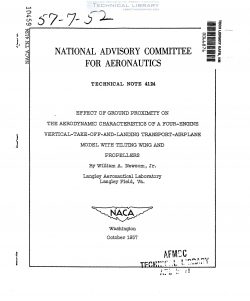naca-tn-4124
- Version
- 137 Downloads
- 689.30 KB File Size
- 1 File Count
- February 2, 2017 Create Date
- February 2, 2017 Last Updated
National Advisory Committee for Aeronautics, Technical Notes - Effect of Ground Proximity on the Aerodynamic Characteristics of a Four-Engine Vertical-Take-Off-and-Landing Transport-Airplane Model with Tilting Wing and Propellers

An investigation.has been made to study the effect of ground prox—
imity on the aerodynamic characteristics of a four-engine vertical-take-
off—and-landing transport-airplane model with tilting wing and propel-
lers. Tests were made with the wing at an angle of incidence of 90°,
the position used for vertical take-off or landing. With the model at
various heights above the ground, the lift, drag, and pitching moment
were measured and tuft studies Were made to determine the flow field
caused by the propeller slipstream. Data were obtained for the complete
model, for the model with horizontal tail removed, and for the wing-
propeller coMbination alone.
The results of the investigation showed that, when the model was
hovering near the ground, there was a strong upwash in the plane of
symmetry and also an increase in lift of about 10 percent of the pro-
peller thrust. About one-half of this lift resulted from an increase
in propeller thrust and one-half resulted from an up load on the fuse—
lage induced by the upwash. As the model approached the ground, it also
experienced an increasing nose-down pitching moment that evidenthy
resulted from the up load on the fuselage, the rear part of which was
longer than the front part. The addition of the horizontal tail which
was located about halfway up the vertical tail did not increase the
nose-down pitching moment because the fuselage decreased the energy of
the upwash before it reached the tail.
During flight tests of four-engine vertical-take—off transport-
airplane models by the Langley FreeéFlight-Tunnel Section (refs. 1 and
2), the models were observed to experience an increasing nose-down
pitching moment as they approached the ground. In reference 2 a short
series of tuft studies was made at the time of the flight tests in
order to get some idea of the flow that waS'being experienced at the
tail. These tests indicated that the nosesdown_pitching moment was
probably being caused by an upwash on theitail, but the tests were not
extensive enough to establish definitely the basic characteristics of
the flow or how the flow was modified by the presence of the fuselage.
From what was learned of the flow field, however, this upwash seemed
to be a fundamental characteristic of airplanes of this type in which
the propellers are located side by side at some distance from the plane
of symmetry with the propeller slipstream directed toward the ground.
| File | Action |
|---|---|
| naca-tn-4124 Effect of Ground Proximity on the Aerodynamic Characteristics of a Four-Engine Vertical-Take-Off-and-Landing Transport-Airplane Model with Tilting Wing and Propellers.pdf | Download |

Comment On This Post